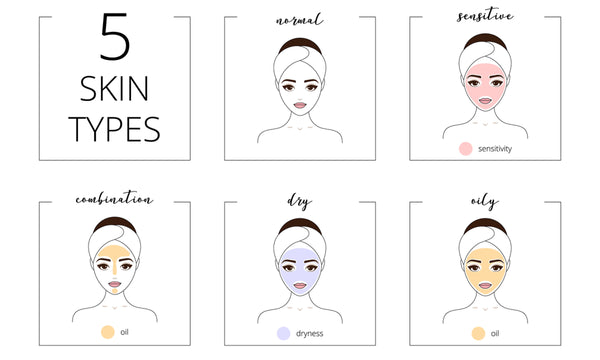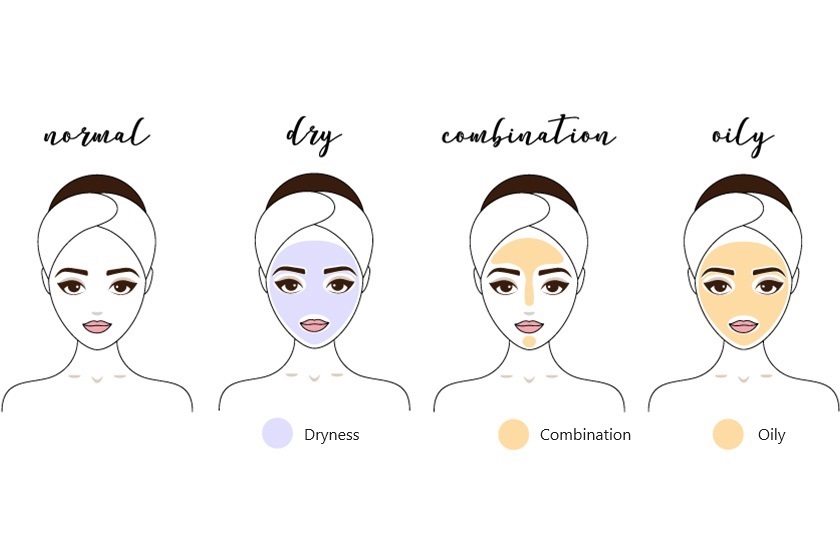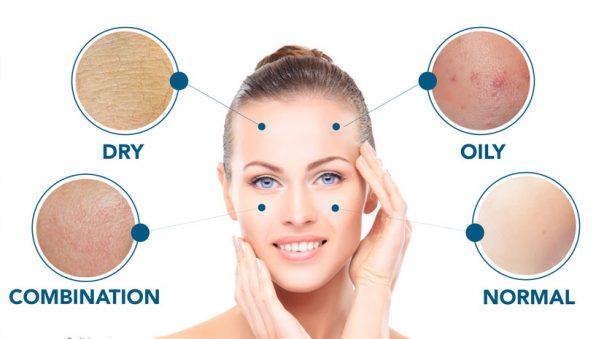What Is My Skin Type?: Discover Your Perfect Skincare Routine
Knowing your skin type is essential for proper skincare. It helps you choose the right products and routines.
But what exactly is your skin type? Your skin type is determined by how much oil your skin produces. It can be oily, dry, combination, or sensitive. Each type has unique characteristics and needs. Understanding your skin type can improve your skincare routine and solve common issues.
In this blog, we’ll guide you through the process of identifying your skin type. You’ll learn simple methods to determine it and tips for taking care of your skin. So, let’s dive in and discover the secrets of your skin!
Identifying Skin Types
Understanding your skin type is the first step in taking good care of your skin. Different skin types need different care. Identifying your skin type helps you choose the right products and routines. Let’s explore the different skin types and their traits.
Normal Skin Traits
Normal skin is balanced. It is not too oily or too dry. People with normal skin usually have:
- Small pores
- Even skin tone
- Soft texture
Normal skin rarely experiences breakouts. It looks radiant and healthy. Here are some more characteristics of normal skin:
| Trait | Description |
|---|---|
| Hydration | Good balance, not too oily or dry |
| Elasticity | Firm and supple |
| Complexion | Clear and even |
People with normal skin can use a variety of products. They should still choose gentle and non-irritating options. Regular cleansing and moisturizing help maintain healthy skin.
Oily Skin Characteristics
Oily skin produces more sebum. Sebum is the oil made by your skin. This type of skin often looks shiny. People with oily skin may have:
- Large pores
- Greasy appearance
- Frequent acne and blackheads
Here are more details about oily skin:
| Trait | Description |
|---|---|
| Hydration | Excessive oil, may feel greasy |
| Elasticity | Often less firm |
| Complexion | Prone to breakouts |
Oily skin needs special care. Use products that control oil production. Choose non-comedogenic products. These do not clog pores. Regular exfoliation helps remove excess oil and prevent acne.
Dry Skin Features
Understanding your skin type is crucial for maintaining healthy and glowing skin. Dry skin, a common skin type, has unique features that require special attention and care. Knowing these features can help you choose the right skincare products and routines. Let’s explore the characteristics of dry skin and how to care for it effectively.
Common Symptoms
Dry skin often feels tight and rough. It may look dull and flaky. Here are some common symptoms you might experience:
- Tightness: Your skin feels tight, especially after washing.
- Rough Texture: The skin surface feels rough to the touch.
- Flaking: Small, white flakes can appear, especially around the nose and mouth.
- Redness: Your skin may appear red or irritated.
- Itching: Dry skin can be itchy, making you want to scratch.
Sometimes, dry skin can also crack, causing pain and discomfort. In severe cases, it might lead to more serious issues like eczema. A table summarizing these symptoms can help you identify if you have dry skin:
| Symptom | Description |
|---|---|
| Tightness | Feeling tight after washing |
| Rough Texture | Skin feels rough to the touch |
| Flaking | Small, white flakes appear |
| Redness | Skin looks red or irritated |
| Itching | Skin feels itchy |
Care Tips
Taking care of dry skin involves using the right products and practices. Here are some tips to help you manage and improve your dry skin:
- Moisturize Regularly: Use a rich, hydrating moisturizer to lock in moisture. Apply it immediately after bathing.
- Avoid Hot Showers: Hot water can strip your skin of natural oils. Opt for lukewarm water instead.
- Use Gentle Cleansers: Choose mild, fragrance-free cleansers that don’t irritate your skin.
- Exfoliate Gently: Remove dead skin cells with a gentle exfoliator once a week. Do not over-exfoliate.
- Stay Hydrated: Drink plenty of water to keep your skin hydrated from within.
Here is a quick daily skincare routine for dry skin:
- Cleanse: Use a gentle, hydrating cleanser.
- Moisturize: Apply a rich moisturizer while your skin is still damp.
- Protect: Use sunscreen with SPF 30 or higher to protect your skin from UV damage.
By following these tips, you can help soothe and improve your dry skin, making it feel comfortable and look radiant.
Combination Skin
Understanding your skin type is key to a good skincare routine. Combination skin can be tricky. It has both oily and dry areas. It needs special care to keep it balanced and healthy.
Identifying Areas
Combination skin has both oily and dry parts. The T-zone (forehead, nose, and chin) is usually oily. Cheeks and other areas can be dry or normal. To identify combination skin:
- Use a gentle cleanser: Wash your face with a mild cleanser. Pat dry and wait for an hour without applying any products.
- Observe your skin: Check for shine in the T-zone and dryness in other areas.
- Note how your skin feels: If your T-zone feels oily but your cheeks feel tight or flaky, you likely have combination skin.
A simple test can help:
| Time After Washing | Skin Condition |
|---|---|
| 1 Hour | Oily T-zone, Dry Cheeks |
| 3 Hours | Shiny T-zone, Normal Cheeks |
| 5 Hours | Very Oily T-zone, Dry Cheeks |
Understanding these patterns helps in choosing the right products.
Balancing Products
Combination skin needs a balanced approach. You need products that manage both oily and dry areas. Here are some tips:
- Choose a gentle cleanser: A mild, non-foaming cleanser works best. It cleans without stripping away natural oils.
- Use different moisturizers: Apply a light, oil-free moisturizer on the T-zone. Use a richer moisturizer on dry areas like your cheeks.
- Exfoliate regularly: Use a gentle exfoliant twice a week. This helps remove dead skin cells and keeps pores clear.
- Apply a balancing toner: A toner with ingredients like witch hazel can help balance oil production.
Here’s a simple product routine:
| Step | Product Type | Recommended Ingredients |
|---|---|---|
| 1 | Cleanser | Salicylic Acid, Tea Tree Oil |
| 2 | Toner | Witch Hazel, Rose Water |
| 3 | Moisturizer | Hyaluronic Acid, Glycerin |
| 4 | Sunscreen | Broad-Spectrum SPF |
Using the right products keeps your skin balanced and healthy.
Sensitive Skin Signs
Understanding your skin type is crucial for effective skincare. Sensitive skin can be tricky to manage. It reacts quickly to various factors. Common signs include redness, itching, and dryness. Recognizing these signs helps in choosing the right products and routines.
Triggers To Avoid
Sensitive skin needs special care. Certain triggers can worsen the condition. Here are some common triggers to avoid:
- Harsh Chemicals: Ingredients like alcohol, sulfates, and fragrances can irritate sensitive skin.
- Extreme Temperatures: Hot showers or cold winds can cause redness and discomfort.
- Stress: Emotional stress can lead to skin flare-ups.
- Rough Fabrics: Wool and synthetic materials can cause irritation.
- Sun Exposure: UV rays can damage sensitive skin, leading to burns and redness.
Using gentle products and avoiding these triggers can help maintain healthy skin. Always read labels and test new products on a small area before full application.
| Trigger | Effect on Skin |
|---|---|
| Harsh Chemicals | Irritation and Redness |
| Extreme Temperatures | Dryness and Discomfort |
| Stress | Flare-Ups |
| Rough Fabrics | Irritation |
| Sun Exposure | Burns and Redness |
Soothing Solutions
Managing sensitive skin involves using the right products and methods. Here are some soothing solutions:
- Gentle Cleansers: Use products free from harsh chemicals.
- Moisturize Regularly: Hydrate your skin with a fragrance-free moisturizer.
- Sun Protection: Apply a broad-spectrum sunscreen with SPF 30 or higher.
- Avoid Hot Water: Use lukewarm water for washing your face and bathing.
- Use Humidifiers: Maintain moisture levels in your home to prevent dryness.
Incorporate these solutions into your daily routine to soothe and protect sensitive skin.
| Solution | Benefit |
|---|---|
| Gentle Cleansers | Reduce Irritation |
| Moisturize Regularly | Hydrate Skin |
| Sun Protection | Prevent UV Damage |
| Avoid Hot Water | Prevent Dryness |
| Use Humidifiers | Maintain Moisture |
By understanding and managing these factors, you can keep your sensitive skin healthy and comfortable.
Skin Type Tests
Understanding your skin type is crucial for effective skincare. Knowing whether your skin is oily, dry, combination, or sensitive helps in choosing the right products and treatments. Skin type tests are simple methods to determine your skin type at home. These tests provide insights into your skin’s needs and how to care for it properly.
Water Test
The Water Test is a straightforward method to determine your skin type. This test involves washing your face and observing how your skin behaves without any products. Here’s how to do it:
- Wash your face with a mild cleanser. Avoid using soap or harsh cleansers.
- Gently pat your face dry with a soft towel.
- Wait for about an hour without applying any skincare products or makeup.
- Observe how your skin feels and looks after the hour.
After completing the water test, you can assess your skin type based on these observations:
| Skin Type | Observation |
|---|---|
| Normal | Feels comfortable, not too oily or dry, smooth and balanced. |
| Oily | Shiny, greasy in the T-zone (forehead, nose, chin). |
| Dry | Feels tight, may have flaky or rough patches. |
| Combination | Oily in the T-zone, dry or normal on the cheeks. |
| Sensitive | Redness, itching, or irritation. |
This method is simple and quick, making it a popular choice for many.
Blotting Sheet Method
The Blotting Sheet Method is another easy test to determine your skin type. This method involves using blotting sheets to measure oil production on different areas of your face. Here’s how to conduct the test:
- Wash your face with a gentle cleanser and pat dry.
- Wait for about an hour without applying any skincare products.
- Take blotting sheets and press them on different areas of your face: forehead, nose, chin, and cheeks.
- Examine the blotting sheets for oil residue.
Based on the oil observed on the blotting sheets, you can determine your skin type:
- Normal: Little to no oil on the blotting sheets.
- Oily: Visible oil on all the blotting sheets.
- Dry: No oil on the blotting sheets, skin may feel tight.
- Combination: Oil on the T-zone sheets (forehead, nose, chin) but not on the cheeks.
- Sensitive: May show oil but also signs of irritation on the blotting sheets.
This method is effective for visualizing oil production and understanding your skin’s behavior. By knowing your skin type, you can choose products that suit your needs and achieve healthier, glowing skin.

Seasonal Changes
Understanding your skin type is crucial for proper skincare. Your skin type can change with the seasons. These changes can affect your skin’s health and appearance. Learn how winter and summer can impact your skin.
Winter Impact
Winter can be harsh on your skin. Cold temperatures and dry air can cause several issues. Your skin might feel tight and dry. Wind can also strip moisture from your skin. Here are some common winter skin problems:
- Dryness
- Flakiness
- Redness
- Irritation
To keep your skin healthy in winter, follow these tips:
- Use a thicker moisturizer.
- Avoid long, hot showers.
- Use a humidifier indoors.
- Wear protective clothing when outside.
These steps can help you maintain your skin’s moisture. It is also important to choose skincare products suitable for winter. Look for products with hyaluronic acid and glycerin. These ingredients help retain moisture.
Summer Adjustments
Summer brings different challenges for your skin. High temperatures and humidity can cause your skin to produce more oil. This can lead to clogged pores and breakouts. Common summer skin issues include:
- Oily skin
- Acne
- Sunburn
- Dehydration
To care for your skin in summer, consider these tips:
- Use a lightweight, oil-free moisturizer.
- Apply sunscreen with SPF 30 or higher.
- Cleanse your face twice a day.
- Drink plenty of water.
In summer, choose products that are non-comedogenic. These products do not clog your pores. Ingredients like salicylic acid can help control oil production. Always reapply sunscreen if you are outside for long periods.
Skincare Routines
Understanding your skin type is essential for creating a skincare routine that works best for you. Different skin types have unique needs and using the right products can make a big difference. A well-planned skincare routine helps you maintain healthy, glowing skin. Let’s explore the best products for each skin type and some useful application tips.
Products For Each Type
Choosing the right products for your skin type ensures your skin gets what it needs. Here’s a quick guide:
| Skin Type | Recommended Products |
|---|---|
| Oily |
|
| Dry |
|
| Combination |
|
| Sensitive |
|
Application Tips
Applying skincare products correctly ensures they work effectively. Here are some tips:
- Cleanser: Use a small amount of cleanser. Massage it gently on your face in circular motions. Rinse with lukewarm water.
- Toner: Apply toner with a cotton pad. Swipe it gently across your face. Avoid the eye area.
- Serum: Use a few drops of serum. Pat it gently into your skin. Allow it to absorb fully.
- Moisturizer: Apply a dime-sized amount of moisturizer. Massage it into your skin. Focus on dry areas.
- SPF: Apply sunscreen every morning. Use enough to cover all exposed areas. Reapply if you stay outside for long.
Consistency is key in skincare. Follow your routine daily for the best results. Always remove makeup before bed. Adjust your routine as your skin changes. Healthy skin comes from good habits.
Consulting Professionals
Understanding your skin type is crucial for a good skincare routine. Sometimes, it’s best to seek help from professionals to get accurate advice. Consulting professionals can provide personalized insights and recommendations tailored to your skin’s unique needs. Let’s explore when to seek help and what to expect during a consultation.
When To Seek Help
Knowing when to consult a professional is important. There are specific signs and situations that indicate you may need expert advice:
- Persistent Skin Issues: If you have ongoing problems like acne, redness, or dryness that don’t improve with over-the-counter products, it’s time to see a professional.
- Uncertain Skin Type: If you’re unsure about your skin type despite trying various products, a professional can help you determine it accurately.
- Severe Reactions: Experiencing severe reactions to skincare products, such as rashes or swelling, necessitates professional advice.
- Special Conditions: Conditions like eczema, psoriasis, or rosacea require specialized care and treatment plans from experts.
Consulting a dermatologist or skincare expert early can prevent issues from worsening. They can offer treatments and guidance that suit your specific needs. Taking professional advice seriously ensures better skin health and effective skincare routines.
What To Expect
During a consultation, you can expect a thorough evaluation of your skin. Here’s a breakdown of what usually happens:
- Initial Assessment: The professional will ask about your skin concerns, current routine, and any allergies or reactions you’ve experienced.
- Skin Examination: A detailed examination of your skin will be conducted to identify your skin type and any underlying issues.
- Discussion: Based on the assessment, the professional will discuss their findings and recommend a personalized skincare routine.
- Treatment Plan: If necessary, they may suggest treatments such as facials, peels, or medical-grade products tailored to your skin’s needs.
Be prepared to answer questions about your lifestyle, diet, and any medications you take. This information helps the professional provide accurate advice. They may also use tools like magnifying lamps or skin scanners to get a better look at your skin. Consultations can provide clarity and direction for your skincare journey. Following the recommended routine and treatments can lead to healthier, more radiant skin.

Frequently Asked Questions
How Can I Identify My Skin Type?
To identify your skin type, observe your skin’s behavior. Normal skin feels balanced, oily skin appears shiny, dry skin feels tight and flaky, and combination skin shows both oily and dry areas.
What Are The Main Skin Types?
The main skin types are normal, oily, dry, and combination. Each type has unique characteristics and requires specific care.
How Does Oily Skin Look?
Oily skin often looks shiny and greasy, especially on the T-zone. It may also have enlarged pores and be prone to acne.
What Causes Dry Skin?
Dry skin is caused by a lack of moisture. Factors include genetics, aging, weather, and harsh skincare products.
Conclusion
Knowing your skin type is crucial for proper skincare. It helps you choose the right products. This can lead to healthier, glowing skin. Identifying your skin type involves simple steps. Pay attention to how your skin feels and looks. Keep it clean and moisturized.
Remember, your skin can change over time. Always stay updated with its needs. Proper care leads to better results. Take the time to understand your skin. Your skin will thank you.




